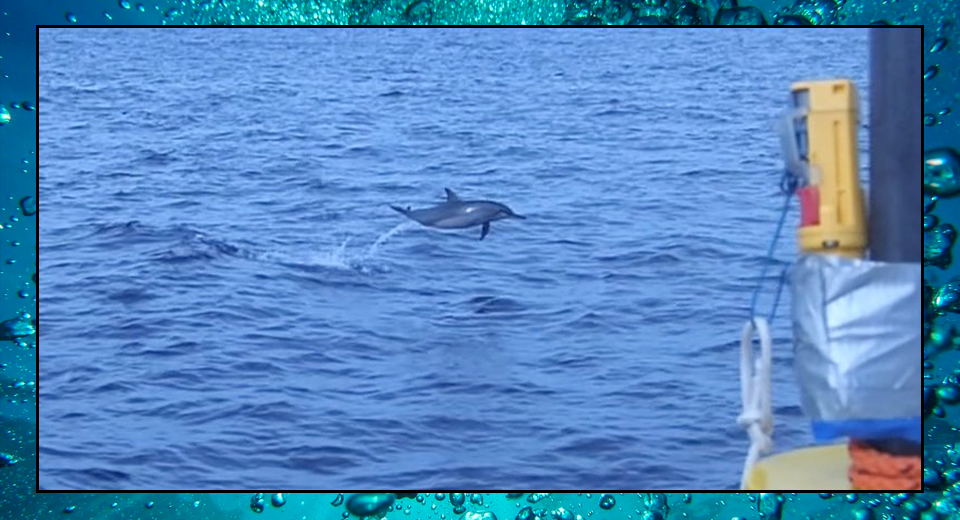Dolphin Ears by Dr Helen Czerski
Sea Shambles Advent Calendar - Day 24December 24th
Dolphins are masters of underwater sound, and yet they appear to have no ears.

Today’s picture was sent in by @Gulfie , and it catches a leaping dolphin in action. It’s possible that at the moment that this was taken, the people standing around the photographer were whooping and cheering with excitement, perhaps even generating enough noise to alert another boatload of humans half a mile away. But the dolphin itself would have been oblivious to the cacophony.
In general in the ocean, when it comes to learning about your environment, sound is far more important than light. Dolphins in particular are known for being both noisy and very sensitive to sound. They’re famous for echolocating, sending out clicks of sound and using the echoes to build up a picture of their environment. The click is created inside the dolphin’s head, and is transmitted outward with the help of the distinctive bulge of a dolphin’s forehead, known as the melon. Any echo bouncing back will only be a tiny fraction of the original click, and so getting the echolocation right requires exceptionally sensitive hearing. And that begs the question: just exactly where is the dolphin hiding its ears?
To get at the answer to this, we need to go back in time a bit. Dolphins and whales evolved from land mammals, and that evolutionary path started perhaps 50 million years ago. So the starting point is that dolphins had the internal apparatus for hearing on land. The sensitive hairs in our inner ear are sitting in a fluid, and a lot of the biological apparatus that we call our “ear” is focussed on one task: getting sound out of the air and funnelling it into this watery inner ear. That’s hard, because sound bounces off boundaries between air and water. To get around this problem, our outer ear (the visible “ear” on the side of our head) and the middle ear just behind it are complex and clever equipment for carefully shepherding sound from air into water, a fiddly and difficult task. Something like this is what the ancestors of the dolphin started out with.
The Cosmic Shambles Network relies on your support on pledges via Patreon so we can continue to provide great, new, exciting content without the need for third party ads or paywalls.
For as little as $1 a month you can support what we do and get some great rewards for doing so as well. Click the Patreon logo to pledge or find out more.
But as soon as those ancestors moved back underwater, the air-water boundary had vanished. Sound travels though the muscles and fat of a dolphin’s body in a very similar way to seawater. Sound can just travel into the dolphin directly, and reach the sensitive inner ear without any help. All that faffing about with external ears become defunct. So although dolphins and whales still have the tube bits (and earwax), they quickly lost their external ears. Those tubes don’t appear to be used hearing at all.
Next question: if sound can travel directly into your body from all directions, how does your ear sort out the delicate task of interpreting echoes from tiny objects many tens of metres away? To some extent, the jury is still out on this, but the short answer seems to be that the dolphin’s jawbone is a particularly important conduit for that sound, amplifying it on the way, and guiding it to the inner ear. So the replacement for a dolphin’s external ear is its jaw, a beautifully streamlined solution for a powerful swimmer like this.
The (small) downside is that now that the external ear has gone, so has any ability to hear in air. The dolphin in the picture will have been enjoying a rare moment of peace and quiet, however much screaming it was provoking in the humans. It wouldn’t have been able to hear them. For a dolphin leaping into the atmosphere to take a breather from the constant chatter of the rest of its pod, auditory ignorance really is bliss.
See what lies behind all the windows of the Sea Shambles Advent here.
 Sea Shambles is a one night only live extravaganza celebrating the oceans. Hosted by Robin Ince and Helen Czerski with Steve Backshall, British Sea Power, Josie Long, Lemn Sissay and more it’s a night of science, comedy, music, lasers and more in which we’ll be turning the Royal Albert Hall into an underwater playground the likes of which you’ve never seen! May 17 2020. Tickets start at just £10! Book here.
Sea Shambles is a one night only live extravaganza celebrating the oceans. Hosted by Robin Ince and Helen Czerski with Steve Backshall, British Sea Power, Josie Long, Lemn Sissay and more it’s a night of science, comedy, music, lasers and more in which we’ll be turning the Royal Albert Hall into an underwater playground the likes of which you’ve never seen! May 17 2020. Tickets start at just £10! Book here.
 Dr Helen Czerski is a physicist, first and foremost, but she’s acquired a few other labels along the way: oceanographer, presenter, author and bubble enthusiast. A regular on The Cosmic Shambles Network, she has also presented a number of acclaimed documentaries for the BBC and Fully Charged. Recently she was awarded the prestigious William Thomson, Lord Kelvin Medal and Prize from the Institute of Physics.
Dr Helen Czerski is a physicist, first and foremost, but she’s acquired a few other labels along the way: oceanographer, presenter, author and bubble enthusiast. A regular on The Cosmic Shambles Network, she has also presented a number of acclaimed documentaries for the BBC and Fully Charged. Recently she was awarded the prestigious William Thomson, Lord Kelvin Medal and Prize from the Institute of Physics.
If you would like to reuse this content please contact us for details
Subscribe to The Cosmic Shambles Network Mailing list here.
The Cosmic Shambles Network relies on your support on pledges via Patreon so we can continue to provide great, new, exciting content without the need for third party ads or paywalls.
For as little as $1 a month you can support what we do and get some great rewards for doing so as well. Click the Patreon logo to pledge or find out more.

